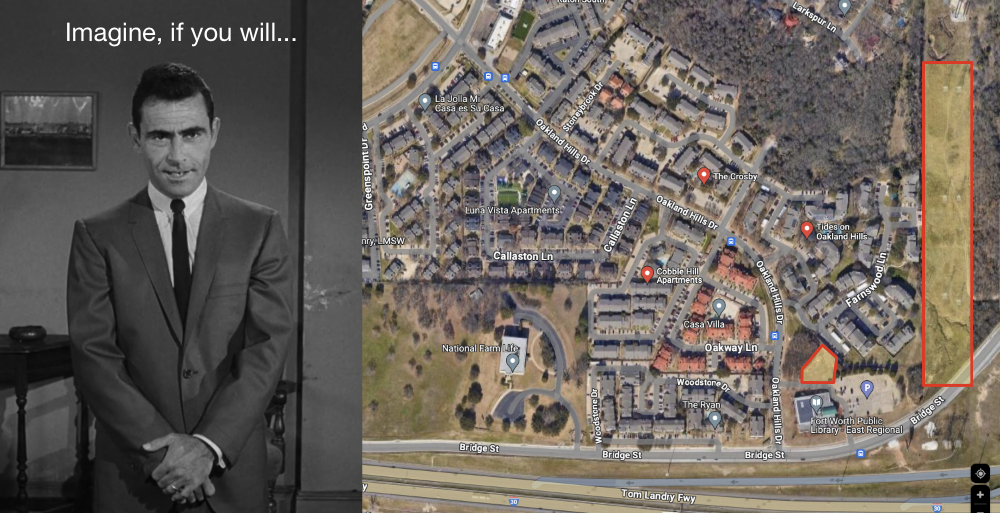One third of U.S. households face an obstacle to EV adoption: They reside in multi-family housing and cannot charge at home.
Public charging can help, but has a few disadvantages for mass EV adoption:
- Cost of DC fast chargers (DCFC) can be as high as $100K to $150K, making them difficult for restaurants or other venues to afford
- Availability of transformers and other grid infrastructure to support DCFC
- Perceived lack of security/lighting for parked EVs, especially if parked for extended periods in remote areas or parking garages
- Inconvenience of non-home charging
- DCFC is too fast (believe it or not) for dining, movies, etc., except for the slowest charging EVs
There is an obvious solution and the fact that it hasn’t already been built astounds me: Level 2 EV charging lots, located near clusters of multi-family housing. Take a look at the image above, or a higher resolution image here.
Land that is now considered undesirable for development, like the large rectangle in the image above, showing a utility easement beneath power lines, could be used for this purpose. Here’s what is needed and how it can be tested and staged, as well as how future developments would augment its usefulness:
- Stage 1 (test phase at the smaller highlighted area)
- Build a parking lot with electric connection boxes at every other parking spot. Each of these boxes should be able to support two 40 amp loads)
- Install inexpensive, hard-wired Level 2 chargers, connected to some subset of these connection boxes. Only install enough for early adopters in the nearby apartment complexes. In the beginning, space the chargers far from one another to prevent door dings or other parking damage.
- Surround the lot with a security fence, motorized gate and security cameras.
- Locate an attendant office/guard shack near the gated entrance but within the fenced perimeter for security. Attendants would not be on duty all night, in the beginning. Similar to storage facilities, there would be posted access hours for drop off and pickup. Weekend hours would be extended later into the night.
- During this roll-out stage, flyers would be mailed to every apartment of the nearby apartment complexes, announcing the creation of the charging center. The lot would be advertised as being within walking distance and secure for overnight, Level 2 charging, which is gentler on the EV batteries. The cost would be a flat monthly fee for unlimited charging for each registered electric vehicle.
- Those adjacent apartment complexes would be encouraged to advertise the convenient charging lot as an amenity to attract potential renters. Perhaps the apartment complex could even include the monthly fee as part of the rent payment, forwarding the membership portion to the charging lot owner, reducing costs.
- Upon arrival, the attendant would log each vehicle and check it against a database of members. Unregistered vehicles would be offered the opportunity to purchase a monthly membership on the spot. The membership could be cancelled at any time, so EV-driving guests of the apartment complex residents could take advantage of it while visiting. (Perhaps for guests, there could be a weekly or day-to-day membership that auto-terminates on a specific date.)
- As demand increases, additional chargers would be installed at the prewired boxes. To accelerate this, flyers could be sent to apartment complexes a little further away.
- When financially feasible, solar canopies would be phased in, parking row by parking row. Since these panels would offer shade during the day and some hail protection, higher priced memberships would be offered to park in the covered rows. The electricity generated would be used for charging and/or sold back to the grid via an energy aggregator. Lighting would be moved to locations below the canopy to reduce light pollution.
- As revenues allow, an electric transit van and driver would be added to take members to and from the lot. An app or website would be developed for drivers to schedule their pickup time and location. When autonomous transit vehicles become cost effective, the transit van would be replaced so no driver would be required.
- If financially advantageous, on-site energy storage could be installed to store solar energy during the day and use it for nighttime charging. Again, the stored energy could be sold back to the grid, when it would result in more revenue than storing it for nighttime charging. This could help stabilize the grid during times of high energy demand.
- As more vehicles with vehicle-to-grid capabilities are made, replace the chargers with units with a vehicle-to-grid (V2G) capability, if there is a revenue advantage. This could be a huge driver for membership sales, as there would be no other way for multi-family residents to participate in the energy arbitrage opportunity that V2G represents. Of course, the low cost Level 2 chargers would have to be replaced with chargers with V2G capabilities.
- Stage 2 (upon completion or during Stage 1, depending on revenues)
- Repeat the steps of Stage 1 at the much larger land parcel (the large highlighted rectangle).
- During this phase, the land purchase or lease may be negotiated with the electric utility as:
- A source of revenue for even more nighttime electricity sales and/or
- A generation facility, using solar canopies installed at the very beginning of construction instead of later, since the economic value would have been established during Stage 1.
- A transit vehicle would become a necessity, as it would be likely that more memberships would be needed than the number that could be generated by the apartment complexes within walking distance.
- During this phase, the land purchase or lease may be negotiated with the electric utility as:
- Repeat the steps of Stage 1 at the much larger land parcel (the large highlighted rectangle).
Now that EV ranges of over 250-300 miles are common, the vast majority of electric vehicles only need to be recharged every 5 days or so. Due to this the number of memberships will be much higher than the number of parking spaces. It may become necessary to install a green/red light system that indicates which parking spots are available (green) when the lots (and number of memberships) become large. I’ve seen this light system in high-demand parking garages. That same information could also be used to update an app or website so drivers can easily see when they can charge.
Somebody please take this idea and run with it. At this point in my life and career, I am not interested in starting a business. Be smart about it. Select an area near a very dense grouping of apartment complexes for your first location.

Remember:
If you build it, they will come.


